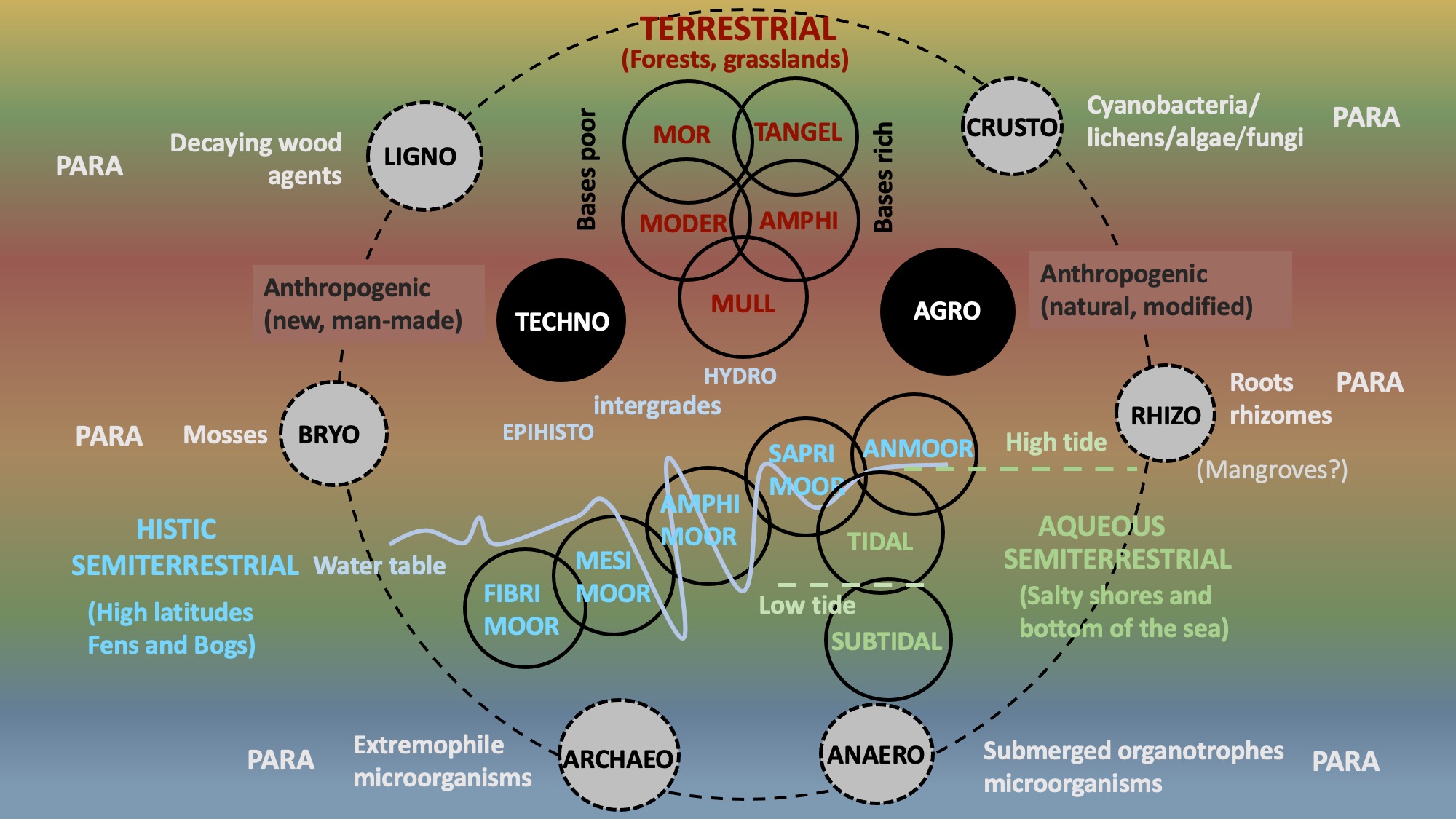Humipedon: organic (H, O) and organo-mineral (A) horizons of a soil profile.
Organic horizons (codes: H, O) are formed of dead organic matter (OM), mainly leaves, needles, twigs, roots and, under certain circumstances, other plant material such as mosses and lichens or remains of hydrophytes. This OM can remain not or little transformed when submerged (H: HF, HM, HS horizons) or be transformed in animal droppings following ingestion by soil/litter invertebrates and/or slowly decayed by microbial (bacterial and fungal) processes (OL, OF, OH horizons). A limit of 20% organic carbon (OC) by mass was established to define O horizons.
Organic-mineral horizons (code: A) are formed near the soil surface, generally beneath organic horizons. Coloured by organic matter, these horizons are generally darker than the underlying mineral layer of the soil profile. In the soil fraction Ø < 2 mm of the A horizon, organic carbon has to be less than 20% by mass. There are terrestrial A horizons that are not or only periodically asphyxiated (maA, meA, miA, sgA, msA), or more or less submerged (anA, anaA).
- humus form
- humus
- soil
- litter
HUMIPEDON
The Humipedon corresponds to the part of the soil richest in organic matter, pedofauna, miroorganisms, seeds and roots of plants (Figure 1). It is also the most active part of the soil, where the processes of mineralization and humification of organic matter take place and also the making of the organo-mineral aggregate of the soil.
A soil profile may be parted in three sections[1]:
1) humipedon (horizons: H, O, A) [2] = organic and organo-mineral soil horizons;
2) copedon (horizons: E, B)[2] = mineral soil horizons;
3) lithopedon (horizon: C, and R layer) = rocky part of the soil, altered rock, top part of the solid Earth crust.

Figure 1. The distinction of Humipedon, Copedon and Lithopedon, with the list of diagnostic horizons in Terrestrial and Semi-terrestrial conditions.
Humipedons are classified into humus systems which are in turn subdivided into humus forms.
There are Terrestrial, Histic, Aqueous, Para nd Anthropogenic humus systems=
- Terrestrial[3]: not or submerged for a few days a year;
- Semiterrestrial:
- Histic[4]: submerged but not subjected to strong daily tides;
- Aqueous[5]: by the sea, in salt water and affected by tides with a daily rhythm.
- Para[6]: These are humipedons either of initial soils or of soils linked to specific "out of standard" environmental conditions. They are represented in gray circles on figure 2.
- Anthropogenic: Agro[7] or Techno[8] humipedons. The former are Terrestrial, Semiterrestrial or Para humipedons modified by man to be cultivated. They contain diagnostic horizons similar to the original natural ones. Techno instead are: 1) maniure humipedons (the different types of composts), 2) soil-free humipedons (from hydroponic solution to porous clay balls), 3) dump humipedons (various types of landfills).

Figure 2. The Para humipedons are represented as satellites of the other humipedons because they can either remain independent, or evolve towards the more developed ones in the central area.
References
- Augusto Zanella; Jean-François Ponge; Jean-Michel Gobat; Jérôme Juilleret; Manuel Blouin; Michaël Aubert; Oleg Chertov; José Luis Rubio; Humusica 1, article 1: Essential bases – Vocabulary. Applied Soil Ecology 2018, 122, 10-21, 10.1016/j.apsoil.2017.07.004.
- Augusto Zanella; Cristian Bolzonella; Jeff Lowenfels; Jean-François Ponge; Marcel Bouché; Debasish Saha; Surinder Singh Kukal; Ines Fritz; Allan Savory; Manuel Blouin; et al. Humusica 2, article 19: Techno humus systems and global change–conservation agriculture and 4/1000 proposal. Applied Soil Ecology 2018, 122, 271-296, 10.1016/j.apsoil.2017.10.036.
- Augusto Zanella; Jean-François Ponge; Bernard Jabiol; Giacomo Sartori; Eckart Kolb; Jean-Michel Gobat; Renée-Claire Le Bayon; Michaël Aubert; Rein De Waal; Bas Van Delft; et al. Humusica 1, article 4: Terrestrial humus systems and forms — Specific terms and diagnostic horizons. Applied Soil Ecology 2018, 122, 56-74, 10.1016/j.apsoil.2017.07.005.
- Augusto Zanella; Rein De Waal; Bas Van Delft; Jean-François Ponge; Bernard Jabiol; Maria De Nobili; Chiara Ferronato; Jean-Michel Gobat; Andrea Vacca; Humusica 2, Article 9: Histic humus systems and forms—Specific terms, diagnostic horizons and overview. Applied Soil Ecology 2018, 122, 148-153, 10.1016/j.apsoil.2017.05.026.
- Augusto Zanella; Chiara Ferronato; Maria De Nobili; Gilmo Vianello; Livia Vittori Antisari; Jean-François Ponge; Rein De Waal; Bas Van Delft; Andrea Vacca; Humusica 2, article 12: Aqueous humipedons – Tidal and subtidal humus systems and forms. Applied Soil Ecology 2018, 122, 170-180, 10.1016/j.apsoil.2017.05.022.
- Augusto Zanella; Jean-François Ponge; Ines Fritz; Nicole Pietrasiak; Magalì Matteodo; Marina Nadporozhskaya; Jérôme Juilleret; Dylan Tatti; Claire Le Bayon; Lynn Rothschild; et al. Humusica 2, article 13: Para humus systems and forms. Applied Soil Ecology 2018, 122, 181-199, 10.1016/j.apsoil.2017.09.043.
- Augusto Zanella; Jean-François Ponge; Stéphanie Topoliantz; Nicolas Bernier; Jérôme Juilleret; Humusica 2, Article 15: Agro humus systems and forms. Applied Soil Ecology 2018, 122, 204-219, 10.1016/j.apsoil.2017.10.011.
- Augusto Zanella; Jean-François Ponge; Stefano Guercini; Clelia Rumor; François Nold; Paolo Sambo; Valentina Gobbi; Claudia Schimmer; Catherine Chaabane; Marie-Laure Mouchard; et al. Humusica 2, article 16: Techno humus systems and recycling of waste. Applied Soil Ecology 2018, 122, 220-236, 10.1016/j.apsoil.2017.09.037.
- Augusto Zanella; Jean-François Ponge; Stefano Guercini; Clelia Rumor; François Nold; Paolo Sambo; Valentina Gobbi; Claudia Schimmer; Catherine Chaabane; Marie-Laure Mouchard; et al. Humusica 2, article 16: Techno humus systems and recycling of waste. Applied Soil Ecology 2018, 122, 220-236, 10.1016/j.apsoil.2017.09.037.
